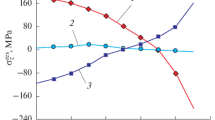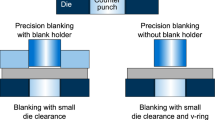Abstract
Cold-drawn calibrated steel is an effective workpiece for the manufacturing of low-stiff cylindrical parts such as shafts and axles. A high accuracy of the diametric size along the workpiece length, low surface roughness, and increased hardness and strength of the surface layer compared to hot rolled products allow the production of a variety of parts with high metal utilization and high machining performance. The main disadvantage of calibrated metal is the residual stresses that occur during pressure processing. To reduce or change the nature of the distribution over the cross section, we propose to use small plastic deformations in the product’s surface layer. Surface plastic deformation (SPD) methods known in practice usually lead to the curvature of non-rigid workpieces. To intensify the stress-strain state in the deformation zone, a method of orbital surface deformation is proposed. The orbital deformation scheme is a rod indenter (tool), one end of which is equipped with a ball tip that is in contact with the surface to be treated. The second end of the rod indenter rotates about the vertical axis, forming a conical surface in space with a certain angle at the apex. A deforming force acts along the rod axis. Based on the finite element modeling, we consider the effect of the main parameters of orbital surface deformation on the stress state in the deformation zone and residual stresses in the finished products. Compared with the traditional SPD process, the stress intensity during orbital surface deformation will increase by 10–15%. The residual compressive stresses formed in the surface layers reach 70–85% of the material tensile strength. The relative radius of the orbital rotation and the radius of the operating tool, at which the formation of maximal temporary and residual stresses is ensured, were established. At an increase in the frequency of the orbital rotation of the operating tool, the temporary and residual compressive stresses increase. In the second part of the paper, we provide information on a more effective method of surface deformation and on the change in initial residual stresses that are formed during the calibration of cylindrical rods.




Similar content being viewed by others
REFERENCES
Zaides, S.A., Okhvatyvayushchee poverkhnostnoe plasticheskoe deformirovanie (Encompassing Surface Plastic Deformation), Irkutsk: Irkursk. Gos. Tekh. Univ., 2001.
Sheftel’, N.I., Uluchshenie kachestva i sortamenta prokata (Improving the Quality and Range of Products), Moscow: Metallurgiya, 1973.
Vishnyakov, Ya.D. and Piskarev, V.D., Upravlenie ostatochnymi napryazheniyami v metallakh i splavakh (Management of Residual Stresses in Metals and Alloys), Moscow: Metallurgiya, 1989.
Papshev, D.D., Otdelochno-uprochnyayushchaya obrabotka poverkhnostnym plasticheskim deformirovaniem (Finishing and Hardening Treatment by Surface Plastic Deformation), Moscow: Mashinostroenie, 1987.
Totten, G., Howes, M., and Inoue, T., Handbook of Residual Stress and Deformation of Steel, Materials Park, OH: ASM Int., 2002.
Handbook of Residual Stress and Distortion of Steel, Totten, G., Howes, M., and Inoue, T., Eds., West Conshohocken, PA: Am. Soc. Test. Mater., 2002.
Ebert, L.J., The role of residual stresses in the mechanical performance of case carburized steel, Met. Trans. A, 1978, vol. 9, pp. 1537–1551.
Swic, A., Taranenko, V., and Wolos, D., New method for machining of low-rigidity shafts, Adv. Manuf. Sci. Technol., 2010, vol. 34, no. 1, pp. 59–71.
Skorokhodov, A.N., Zudov, E.G., Kirichkov, A.A., and Petrenko, Yu.P., Ostatochnye napryazheniya v profilyakh i sposoby ikh snizheniya (Residual Stresses in the Profiles and Ways to Reduce Them), Moscow: Metallurgiya, 1985.
Odintsov, L.G., Uprochnenie i otdelka detalei poverkhnostnym plasticheskim deformirovaniem: spravochnik (Hardening and Finishing of Parts by Surface Plastic Deformation: Handbook), Moscow: Mashinostroenie, 1987.
Dimarogonas, A.D., Dynamic instability of shafts during machining, J. Sound Vib., 1986, vol. 108, no. 2, pp. 181–189.
Kramer, I.R., Effect of surfaces on mechanical behavior of metals, in Surface Phenomena, Bonis, L.J., Bruyn, P.L., and Duga, J.J., Eds., New York: Springer-Verlag, 1995, pp. 171–193.
Bussu, G. and Irving, P.E., The role of residual stress and heat affected zone properties on fatigue crack propagation in friction stir welded 2024–T351 aluminum joints, Int. J. Fatigue, 2003, vol. 25, no. 1, pp. 77–88.
Blyumenshtein, V.Yu., Krechetov, A.A., and Makhalov, M.S., Modern competitive technologies for finishing and hardening processing by surface plastic deformation, Uprochnyayuschie Tekhnol. Pokrytiya, 2012, no. 7, pp. 7–12.
Lebedev, V.A., Effektivnye technologii poverkhnostnogo plasticheskogo deformirovaniya i kombinirovannoi obrabotki (Effective Technologies of Surface Plastic Deformation and Combined Processing), Kirichek, A.V., Ed., Moscow: Spektr, 2014.
Zaides, S.A., New methods of surface plastic deformation in the manufacture of machine parts, Vestn. Magnitogorsk. Gos. Tekh. Univ. G.I. Nosova, 2018, vol. 16, no. 3, pp. 129–139.
Zaides, S.A. and Nguyen Van Huan, Determination of residual stresses in the calibrated roll, Izv. Vyssh. Uchebn. Zaved., Chern. Metall., 2017, vol. 60, no. 2, pp. 109–115.
Tekhnologiya i instrumenty otdelochno-uprochnyayushchei obrabotki detalei poverkhnostnym plasticheskim deformirovaniem: spravochnik (Technology and Tools for Finishing and Hardening of Parts by Surface-Plastic Deformation: Handbook), Suslov, A.G., Ed., Moscow: Mashinostroenie, 2014, vol. 1.
Blyumenshtein, V.Yu. and Makhalov, M.S., Influence of the modes on formation of residual stresses in surface layer during dimensional combined rolling, Obrab. Met., 2008, no. 2, pp. 15–22.
Hauk, V., Structural and Residual Stress Analysis by Nondestructive Methods: Evaluation, Application, Assessment, Amsterdam: Elsevier, 1997.
Zaides, S.A. and Pham Van Anh, RF Patent 2019105314, 2019.
Bakov, K.A., ANSYS. Spravochnik pol’zovatelya (ANSYS: User’s Guide), Moscow: DMK Press, 2005.
Bruyaka, V.A., Fokin, V.G., and Kuraeva, Ya.V., Inzhenernyi analiz v ANSYS Workbench (Engineering Analysis at ANSYS Workbench), Samara: Samar. Gos. Tekh. Univ., 2013.
Author information
Authors and Affiliations
Corresponding authors
Additional information
Translated by A. Ivanov
About this article
Cite this article
Zaides, S.A., Pham Van Anh Improvement of Calibrated Steel Quality by Surface Deformation. Part 1: Determination of the Stress State of Cylindrical Parts during Orbital Surface Deformation. Steel Transl. 50, 745–749 (2020). https://doi.org/10.3103/S0967091220110145
Received:
Revised:
Accepted:
Published:
Issue Date:
DOI: https://doi.org/10.3103/S0967091220110145




